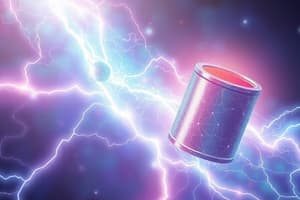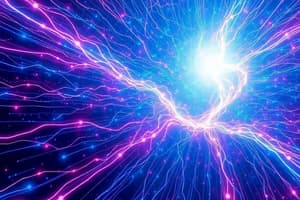Podcast
Questions and Answers
The first topic covered in the lecture is ______.
The first topic covered in the lecture is ______.
Coulomb’s Law
The electric field is discussed in lecture number ______.
The electric field is discussed in lecture number ______.
2
The last topic mentioned for the next lecture is ______.
The last topic mentioned for the next lecture is ______.
Electric Field Lines
The date of the lecture is ______.
The date of the lecture is ______.
The lecturer's name is Prof. ______ Sayed Abd El-sadek.
The lecturer's name is Prof. ______ Sayed Abd El-sadek.
Students can refer to videos linked in lecture for further ______.
Students can refer to videos linked in lecture for further ______.
Flashcards
Coulomb's Law
Coulomb's Law
Describes the force between electrically charged objects.
Electric Field
Electric Field
A region around a charged object where another charged object feels a force.
Electric Field Lines
Electric Field Lines
Visual representations of the electric field's direction and strength.
Activity
Activity
Signup and view all the flashcards
Next Lecture
Next Lecture
Signup and view all the flashcards
Lecture 1
Lecture 1
Signup and view all the flashcards
Study Notes
Course Information
- Course Title: Electricity and Magnetism (PHY211)
- Fall Semester 2024
- Offered by the Department of Basic Science
- Instructor: Prof. Mahmoud Sayed Abd El-sadek
- Email: [email protected]
- Course Credits: 3
Lecture Strategy
- Interactive learning methods used in lectures and labs.
- Students will prepare for lectures, participate in discussions.
- Students will be involved in finding information from references.
- Quizzes, assignments, presentations are included.
- Flipped classroom method used in some lectures
General Rules for Lectures
- Lecture duration: 2 hours
- Break after the first hour
- Second half will be a combination of lecture and activity.
- No cell phones during lectures; be quiet.
Course Grading
- Assessment not 100% exam-based.
- Grade distribution includes:
- Participation Quizzes and Assignments: 20%
- Midterm Exam: 10%
- Lab Book Reports: 15%
- Practical Exam: 15%
- Final Exam: 40%
- Overall weighting:100%
- Coursework includes attending lectures, presentations, projects and assignments and quizzes.
Course Topics
- Chapter 1: Coulomb's Law
- Chapter 2: Potential difference
- Chapter 3: Ohm's Law
- Chapter 4: Work and Energy
- Chapter 5: Kirchhoff's law
- Chapter 6: Magnetism
- Chapter 7: Faraday's law
- Chapter 8: Wave motion
- Chapter 9: Geometrical optics
- Chapter 10: Optical Instruments
Chapter 1: Electric Charge and Coulomb's Law
- Lecture Layout Includes:
- Electric charges:
- Conductors and Insulators
- Charging
- Activities
1 - Electric Charge
- Charge (q or Q) is measurable. Unit: Coulomb (C)
- Charge is quantized (comes in units of 1.6 x 10⁻¹⁹ C).
- Elementary particles in atoms include:
- Protons: +e = +1.6 x 10⁻¹⁹ C
- Neutrons: Uncharged
- Electrons: -e = -1.6 x 10⁻¹⁹ C
- Neutral bodies have equal positive and negative charge.
- Charged bodies exert force on each other.
- Like charges repel.
- Opposite charges attract.
2 - Insulators and Conductors
- Electrical Conductors: materials that have free electrons that move through the material.
- When a conductor is charged in a small area, it distributes over the entire material surface.
- Example: Copper is a conductor.
- Electrical Insulators: materials with no free electrons, electrons are bound to atoms.
- Example: Plastic is an insulator.
- Semi Conductors: materials with properties between conductors and insulators; resistivity increases with decreasing temperature.
- Examples: Silicon and Germanium.
3 - Charging
- Charging by conduction: Direct contact between charged and neutral objects. Charged object shares charge with the uncharged object.
- Charging by induction: No contact required. Charged object induces charge on another object.
4 - Activities
- Questions are posed about physical phenomena and concepts involving charge and electricity.
- A charged rod attracts dry cork dust but bounces away after touching it.
- Ways to discharge a charged insulator are mentioned.
- The reason why a coin does not become charged by friction.
Next Lecture
- Topics are noted for the following lecture:
- Coulomb's Law
- Electric Field
- Electric Field Lines
Studying That Suits You
Use AI to generate personalized quizzes and flashcards to suit your learning preferences.




